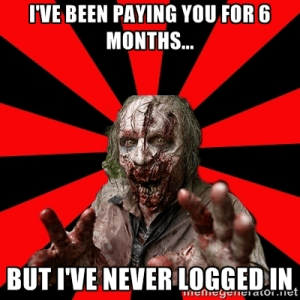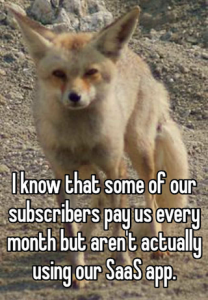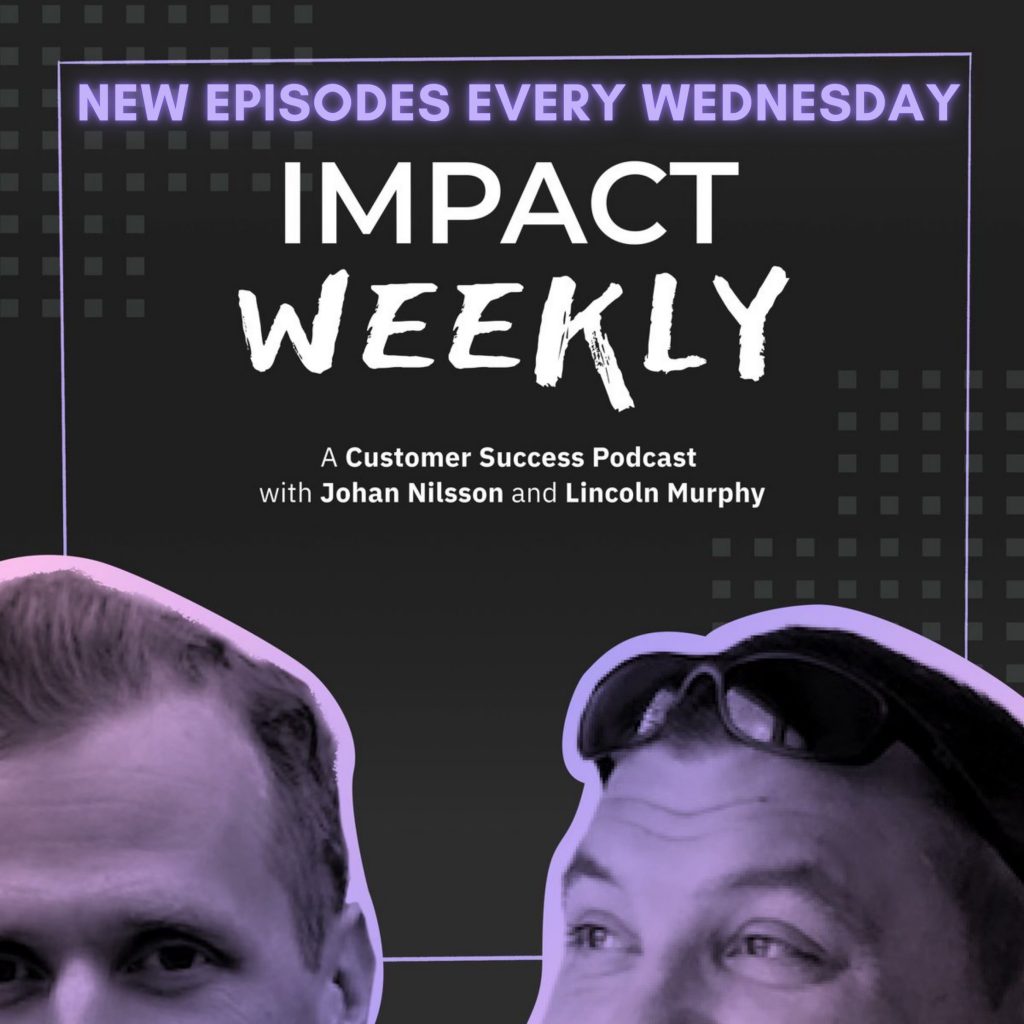 So I got this email the other day asking me a SaaS Customer Success question that’s really more about ethics and karma than running a SaaS business.
So I got this email the other day asking me a SaaS Customer Success question that’s really more about ethics and karma than running a SaaS business.
The gist of the email was what to do if a customer has been paying for 6 months but never started using the SaaS product…. these are what I call Zombie Customers.
I’ve attempted to answer the question in a meaningful way, but I am the first to acknowledge that there is a lot more to it than just what I talked about in this post.
That said, it’s a pretty straightforward question with a pretty straightforward answer… that you will completely disagree with!
Here we go…
Here’s Susan’s question:
Hi Lincoln. You talk a lot about on-boarding and getting customers engaged and using your app quickly. We have a couple of customers that have been customers for 6 months or more that haven’t done anything in our software except pay us every month. I don’t like taking their money if they’re not using our software but I don’t want to say anything that might cause them to cancel. Thoughts? – Susan
Here’s my answer:
Hmmm… this is pretty simple, it only has two parts. Ideally, these two parts should be executed in parallel.
Part One: Operationalizing Customer Success
Re-engineer your on-boarding process to get people quickly engaged and then work to drive continual engagement over the the entire customer lifetime. Do not let this scenario occur in the first place… or at least ever again.
Some ideas to consider:
- Customer Success: The Definitive Guide
- Desired Outcome drives Customer Success
- The Secret to Successful Customer Onboarding
Part Two: Do the Right Thing
 For your customers that have been inactive for 1 – 6 months, reach out directly and get them on-board…. See step one above for some ideas on doing that now (specifically the ‘concierge’ idea).
For your customers that have been inactive for 1 – 6 months, reach out directly and get them on-board…. See step one above for some ideas on doing that now (specifically the ‘concierge’ idea).
But for those who have been paying but inactive for > 6 months – aka Zombie Customers – follow these steps precisely for each of them:
- Stop billing them and freeze/hibernate their account
- Get the actual customer name and mailing address <== you might have to call them or do manual research
- Write a check for what the customer has paid you for the 6 months (or more) of not using your system. Do not take out CC fees, admin fees, or anything else that makes you look petty… consider those goodwill costs.
- Write a nice note and say something like: “Thanks for being our customer for the past 6 months! That’s awesome. But we saw that you haven’t used your account since you signed-up, and we just can’t take your money if you’re not going to use our app. Enclosed is a refund check for the past 6 months in the amount of $x,xxx. We’ve hibernated your account and stopped processing payments. However, when you’re ready to come back to [our SaaS] just let us know and we’ll restart everything for you. Please let me know if you have any questions. – Susan Lastname, CEO” <== be sure to include your direct contact info
- Put the check and the letter in a FedEx (or equivalent) envelope
- Send the FedEx envelope
- The day the package is supposed to arrive, send them an email or call them and let ’em know there’s a FedEx envelope coming their way and to be on the lookout for it
- Smile. You did the right thing
- Go check on the progress of Part One so this never happens again
- Only ask them why they never got started if they reach out to thank you for the proactive refund… otherwise just let ’em go.
It’s the right thing to do and a tasty way to do it, though I am interested in how people will disagree with me on this. I bet I know a couple of ways…
Cool Story Bro… But Who’s Actually Done This?
Inevitably I’m asked for an example whenever I post ideas like this. A case study. A reference. Everyone wants to know who’s done this before.
Why? I’m not sure… maybe it’s some form of validation for what they already perceive to be a good idea. I mean… if you didn’t think this was a good idea, you probably wouldn’t even ask who’s done it before, right? You’d just move on.
But if you think it’s a good idea, but apparently don’t trust your own instincts enough to act on this good idea, then you need to know that someone smarter and more successful than you has already done it.
What if – and believe me this is a hypothetical – but what if no one in the entire history of all the multiverse incarnations out there has ever done this before? What if I made up the response to Susan because I just thought it was a good idea?
What now? Does this purportedly good idea – your words not mine – go untested because someone who’s Twitter-famous didn’t say it first? Or because someone who runs an “accelerator” didn’t twerk about it in a Vine post?
Maybe start doing things because you feel like they’re the right thing – for business, ethically, etc. – even if you can’t find an example of anyone else doing it, ever. That’d be a little bit innovative, huh?
That said, the answer is yes… I’ve done this before and it had the desired effect (but I won’t tell you which of my clients did this).
On the other hand, I’ve also suggested it several times and had it fall on deaf ears… ears that belonged to a head with a mouth that already expressed remorse for taking people’s money without providing value.
Look… I can’t make you do the right thing, I can only suggest it.
Ideology vs. Reality
But you have to know that I’m not some ideolog spewing “advice” without taking into consideration the potential consequences of an action.
I’m fully aware that this will ding your cash flow. If that will cause you to go out of business, then perhaps doing this is not the right move, right now.
Everything is relative… use your good judgement. If you can’t do this because it will cause you to go out of business, harm your family, etc. then just go work on Step One above so this never happens again.
Understand though, that if you can’t do the right thing because it will hurt your cash flow and possibly cause you to go out of business… then you’ve built a business on doing the wrong thing. Think about that for a minute.
That said, if a majority of your customers are paying you and not using your app, you’ll probably not want to do Option Two from above… but you should do something, and quick.
The Gym Membership Model
According to data from the fitness center industry itself, 67% of all gym memberships go unused. We all know that the best members of a Fitness Center are the ones that don’t show up, right, but wow… 67% is insane.
If gyms gave members their money back for not showing up, there would simply be NO gym industry. They’d be better off giving people their money back FOR showing up. It would be cheaper.
So how do we reconcile this gym membership data with that of a SaaS business?
First… I have some ties with the fitness industry and those with whom I work do everything they can to encourage use. Their “unused membership” numbers are exponentially lower than the national average.
Second… we don’t. This is SaaS… not gym memberships. Anecdotal evidence suggests people actually do get value from having a gym membership and not going… it’s psychological. They feel better about themselves. They might even feel healthier. And that might even make them actually healthier.
That probably doesn’t translate to your Project Management app… but it might?!?!
Inactively Recognizing Value
You have to know your customers. Hiding from them doesn’t allow you to do that.
If you find that your inactive customer rates jibe with those of the Fitness industry, on the surface that seems bad so it’s time to do some digging.
Pick up a phone or punch some numbers into a soft-phone and call your customers.
Find out why they pay you but don’t use your app.
Maybe there’s a really good reason. Maybe. But I don’t like maybes.
Find out for sure or your business could be sitting on a house of cards (there’s probably a credit-card pun here… but I’ll refrain).
But there could be some legit reasons for such a large swath of inactive users.
For instance, I have clients that have me on retainer… they might not talk to me for a couple of months but when they need me, I’m there for them. So are they getting value from me even when we aren’t working together directly? Yes…. because I’m there for them when they need me.
Consultants, Lawyers, and other professionals all have some type of retainer relationship with their clients that are designed around inactivity.
Are your inactive customers paying you the equivalent of a retainer fee? Are they worried their current solution is going to break, go away, or otherwise be inaccessible?
Are you just there if they need you?
Or maybe it’s something else…
Is there a seasonal element in your industry you didn’t know about and they’re about to start using it?
Is there a budgetary issue you weren’t privy too that forces people in your industry to make purchases at certain times of the year even though they don’t need the thing they’re buying right then. That if they think they might need it, they need to jump on it?
I don’t know… and you won’t either until you talk to your customers.
Zombies Feed On Your Reputation
The bottom line is, Zombie Customers are bad because every once in a while they come back to life and get super-pissed that they were paying you for 6 months and not getting anything from it.
If anything, these customers that are paying you, that aren’t getting value from your service… that you’re hiding from… they’re a massive churn threat.
They WILL realize they’re paying you for something they’re not using some day… and they will leave.
And they will likely be quite upset with you.
And they will tell others not to use you, but it’ll be for made-up negative reasons so they don’t have to admit they paid for something they didn’t use!
Do the right thing and just add value. Period.
If you’re not adding value stop what you’re doing. Simple.
Oh, and if good karma isn’t enough…. how likely is it that a picture of the refund check, your letter, and the FedEx envelope will end up on Instagram or Twitter with the hashtag #awesomecustomerservice along with your name?


